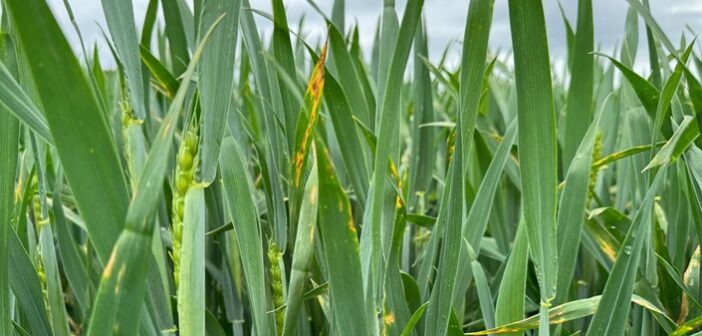With septoria and rust romping away in a wide range of varieties, and ideal fusarium conditions in many areas, a well-timed T3 spray could be crucial to help protect remaining yield and quality potential, advises Stuart Sutherland, technical manager at Interagro.
“The T3 spray is the last opportunity to safeguard wheat crops from disease, to optimise yield building on the run-up to harvest. It’s been the perfect storm for wet weather diseases like septoria but we’re also seeing yellow rust and brown rust in some varieties, dependent on the timeliness and success of the T2 spray, and localised weather conditions.
“With conditions now also perfect for overwintering fusarium it will break dormancy and begin to produce spores. A well timed, on-target T3 spray serves three important functions – topping up foliar disease control, protecting the ear against fusarium and michrodochium, and prolonging green leaf area to extend photosynthesis and the yield-building phase.”
Stuart warns timing is crucial. “Don’t wait until flowering has started in milling wheats as this will be too late to properly protect the ear. As soon as ear emergence is complete, get your fungicide(s) applied.
“Spores can travel locally from residues with rain, or travel many miles, landing into fields. Where crops are inadequately protected, these spores will be able to infect exposed crops via the glumes/spikelets and could eventually grow into the rachis, cutting off water and nutrient movement above the point of infection.”
However, with much of the country still experiencing unsettled weather, the timely application of fungicides is easier said than done. For this reason, he advises incorporating adjuvant Kantor. “Unlike most adjuvants that can only be used at T3 in cereals when using half the approved rate of fungicide, Kantor can be used with all authorised triazole fungicides at their full recommended rate and latest timing.
“Kantor provides significant drift reduction and improves rainfastness, extending the spray window for fungicide application.”
He points to controlled spray droplet research at Silsoe Spray Applications Unit as well as large plot in-field deposition studies conducted by Agrii.
“At Silsoe, the research looked at the effect of Kantor on the common T3 fungicide, Kestrel (prothioconazole and tebuconazole). The inclusion of Kantor reduced the number of drift-prone spray droplets – droplets less than 100 microns – by 23%, and increased the volume mean diameter by 10%. That’s a measure of spray angle uniformity at the nozzle, and is important in terms of spray quality.”
Superior target coverage aids disease protection
The trials also revealed superior efficacy. Stuart reminds that ear sprays can be particularly challenging as the glumes of wheat are not an easy target to hit with fungicide.
“Even the best fungicides can struggle to control fusarium spp and michrodochium nivale. Teaming fungicide sprays with Kantor at a rate of 0.15% of the final spray volume, not only improves spray deposition on the ear, it also improves fungicide coverage across the ear and leaf layers leading to superior disease protection.
“This is achieved by lowering the surface tension between the spray solution and waxy cuticle of the ear/leaf surface, enabling the fungicide to spread out and cover those crucial parts of the wheat plant. This is vital for the fungicide to be able to block invading disease spores from entering the ear/upper leaves of the plant,” stresses Stuart.
Replicated field trials by the company have shown the ability of the T3 spray to payback and improve disease control and yield gains by including Kantor.
“At milling wheat prices of £250/t, an average reduction of 4% in fusarium infection and a yield increase of 0.5 t/ha over fungicide alone, works out around £119/ha margin over input cost,” he concludes.




